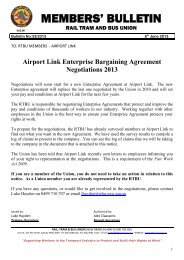Safety Matters - Rail, Tram and Bus Union of NSW
Safety Matters - Rail, Tram and Bus Union of NSW
Safety Matters - Rail, Tram and Bus Union of NSW
You also want an ePaper? Increase the reach of your titles
YUMPU automatically turns print PDFs into web optimized ePapers that Google loves.
The report also identified ‘human factors’ such as the train guards’ inadequate<br />
training <strong>and</strong> rostering leading to fatigue <strong>and</strong> diminished capacity to assess<br />
<strong>and</strong> respond to what was occurring.<br />
These are issues that are <strong>of</strong> concern to all employees employed by all private<br />
<strong>and</strong> public transport operators. It will be increasingly necessary for <strong>Union</strong> <strong>and</strong><br />
OHS representatives in the workplace to be actively engaged in the systematic<br />
management <strong>and</strong> monitoring <strong>of</strong> OHS systems in their workplace. There is also<br />
a responsibility on the <strong>Union</strong> <strong>and</strong> its members <strong>and</strong> all those involved in OHS to<br />
identify key areas <strong>of</strong> concern <strong>and</strong> to work towards effective solutions.<br />
Developing OHS Management Systems<br />
The systematic <strong>and</strong> strategic management <strong>of</strong> OHS is vital in preventing<br />
workplace accidents, injuries <strong>and</strong> illness. This involves developing formal<br />
<strong>and</strong>/ or informal management systems for dealing with occupational health<br />
<strong>and</strong> safety matters. That is, OHS should be integral to the overall strategic<br />
business planning <strong>of</strong> the company, <strong>and</strong> not viewed as an ‘add-on’ or side<br />
issue.<br />
The Australian St<strong>and</strong>ard for Occupational Health <strong>and</strong> <strong>Safety</strong> Management<br />
Systems (AS 4804 1997) defines an OHS management system as:<br />
The part <strong>of</strong> the overall management system which includes<br />
organisational structure, planning activities, responsibilities, practices,<br />
procedures, processes <strong>and</strong> resources for developing, implementing,<br />
achieving, reviewing <strong>and</strong> maintaining the OHS policy, <strong>and</strong> so managing<br />
the OHS risks associated with the business or the organisation’.<br />
Principles <strong>of</strong> Occupational Health <strong>and</strong><br />
<strong>Safety</strong> Management Systems (OHSMS)<br />
The Act <strong>and</strong> its supporting regulatory <strong>and</strong> advisory framework provide broad<br />
objectives <strong>and</strong> in some circumstances, detailed guidance to assist employers,<br />
employees <strong>and</strong> others in achieving health <strong>and</strong> safety. The legislative framework<br />
must be considered <strong>and</strong> applied specifically in relation to each individual<br />
workplace in order to achieve optimum health <strong>and</strong> safety.<br />
However, due to the complexity <strong>of</strong> workplaces, the interaction <strong>of</strong> people, plant,<br />
substances <strong>and</strong> systems, the organisational structure <strong>and</strong> workforce culture,<br />
BACK TO CONTENTS<br />
<strong>Safety</strong> <strong>Matters</strong> A Guide for Workplace OHS Representatives<br />
SECTION TWO<br />
RAIL<br />
TRAM AND BUS<br />
15<br />
Monitoring OHS Programs <strong>and</strong> Procedures<br />
U N<br />
I O N

















